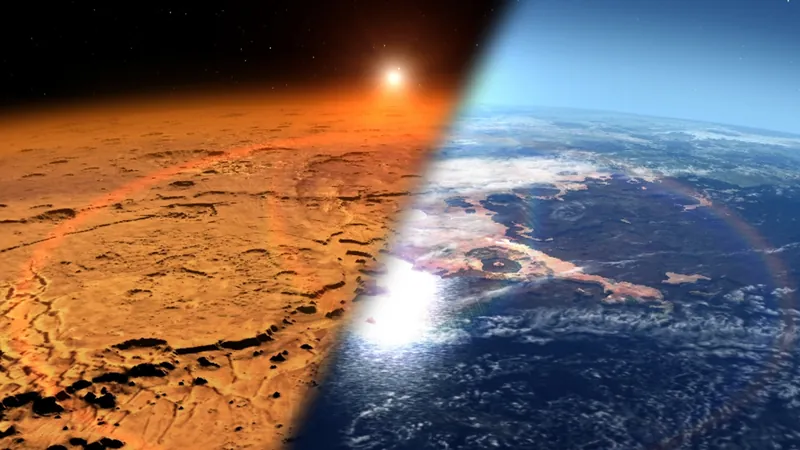
NASA's MAVEN Discovers Solar 'Cannonballs' That Stripped Mars of Water – A Theory Finally Confirmed!
2025-06-03
Author: Ming
NASA's Groundbreaking Discovery about Mars!
After nearly ten years orbiting the Red Planet, NASA's MAVEN spacecraft has made an astonishing revelation: it has directly observed the mechanism believed to have stripped Mars of its once-thick atmosphere. This groundbreaking finding, detailed in a recent article in Science Advances, offers crucial insights into how Mars devolved from a warm, water-rich world into the cold desert we see today.
From Habitable to Hostile: The Transformation of Mars
Once adorned with rivers and possibly seas, Mars now stands as a dry landscape, yet its surface is littered with signs of its wetter past—ancient river valleys and lake beds tell a tale of liquid water. To sustain such life-giving water, Mars needed a robust atmosphere that could trap heat. Understanding how this atmosphere vanished is vital for piecing together the planet's climatic history and assessing whether it could have remained habitable longer.
The Role of Solar Wind in Mars' Fate
For years, scientists have theorized that solar wind—the continuous influx of charged particles from the sun—played a major role in eroding Mars' atmosphere. A crucial process in this erosion is sputtering, where high-energy solar particles collide with Mars' upper atmosphere, dislodging atoms and sending them flying into space.
Shannon Curry, principal investigator of the MAVEN mission, likened this process to "doing a cannonball in a pool," where the energetic ions create splashes of escaping atoms.
First Direct Observation of Sputtering!
While sputtering has been suspected for years, this is the first time it has been directly observed. By analyzing nine years of MAVEN data, researchers uncovered current sputtering activity on Mars.
Game-Changing Findings on Argon Levels
Using data from three of MAVEN's advanced instruments, scientists crafted a detailed map showcasing argon levels in Mars' atmosphere. Argon serves as an excellent tracer for atmospheric escape due to its inert nature and weight. Findings revealed unexpectedly high argon concentrations at altitudes where solar particles collide with the Martian atmosphere.
This surge in argon clearly indicates that sputtering is actively occurring, reinforcing the notion that this process has played a pivotal role in stripping away Mars' atmosphere and diminishing its capacity to sustain liquid water.
Accelerated Atmospheric Erosion: New Insights!
MAVEN's findings pushed the believed rate of sputtering to four times higher than earlier estimates. This process intensified during solar storms, offering a glimpse of how massively energetic solar events may have affected Mars as a young planet.
A Vulnerable Planet: Mars' Early History
Scientists suspect that billions of years ago, when the Sun was notably more active and Mars had lost its magnetic shield, sputtering could have been even more destructive. This absence of protection exposed Mars’ atmosphere to relentless solar wind, leading to its dramatic thinning and making it impossible for liquid water to exist.
Unraveling Mars' Climate History
Curry asserts that these results decisively link sputtering to the atmospheric loss on Mars, shaping the history of water on the planet. However, to understand whether sputtering was the leading force behind Mars' climatic change, further investigation into ancient records will be paramount.
Scientists will dig deep, looking at billions of years of data to determine if sputtering merely skimmed the atmosphere or truly stripped it bare.
The Future of Mars Exploration
As we continue to explore Mars, these findings not only challenge our understanding of the planet’s past but also spotlight the importance of its climatic evolution in the search for extraterrestrial life.





 Brasil (PT)
Brasil (PT)
 Canada (EN)
Canada (EN)
 Chile (ES)
Chile (ES)
 Česko (CS)
Česko (CS)
 대한민국 (KO)
대한민국 (KO)
 España (ES)
España (ES)
 France (FR)
France (FR)
 Hong Kong (EN)
Hong Kong (EN)
 Italia (IT)
Italia (IT)
 日本 (JA)
日本 (JA)
 Magyarország (HU)
Magyarország (HU)
 Norge (NO)
Norge (NO)
 Polska (PL)
Polska (PL)
 Schweiz (DE)
Schweiz (DE)
 Singapore (EN)
Singapore (EN)
 Sverige (SV)
Sverige (SV)
 Suomi (FI)
Suomi (FI)
 Türkiye (TR)
Türkiye (TR)
 الإمارات العربية المتحدة (AR)
الإمارات العربية المتحدة (AR)